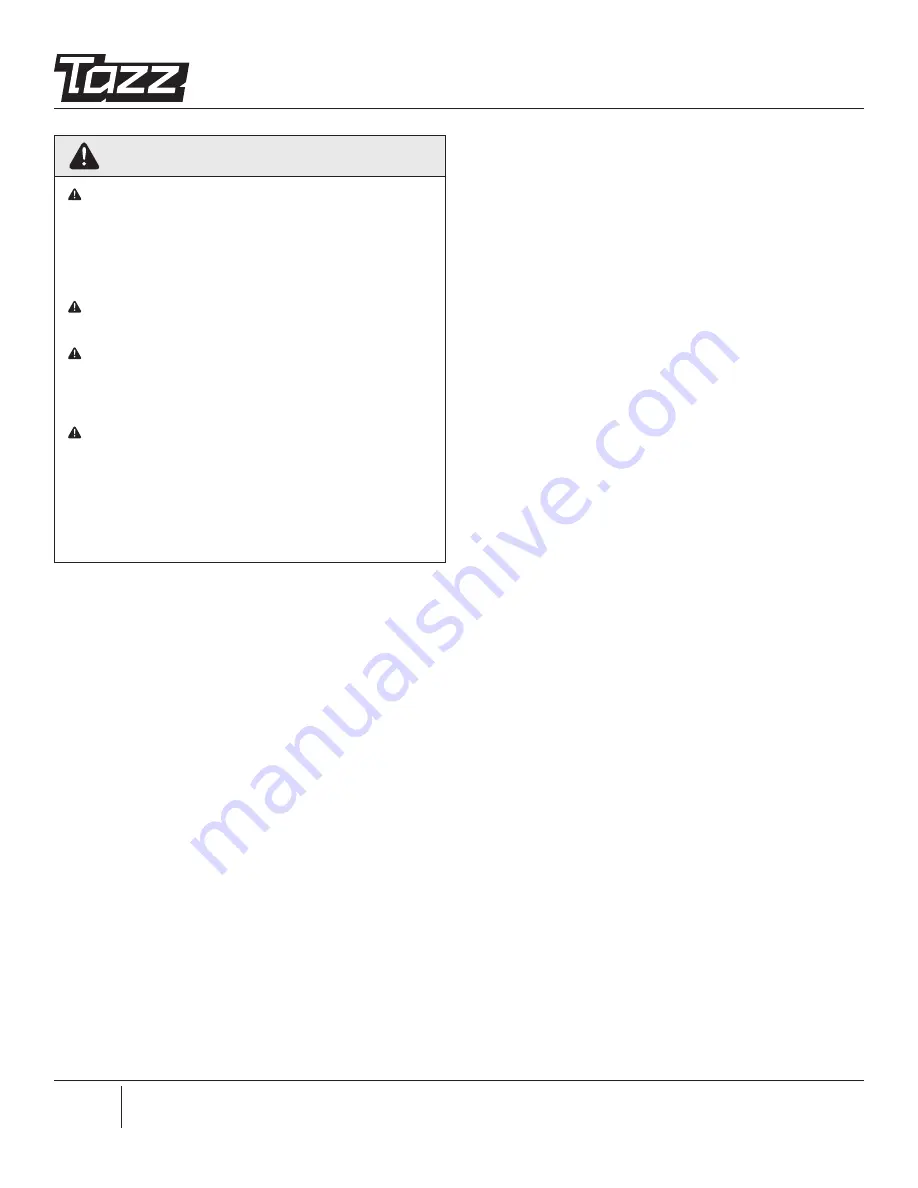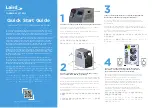
6
Owner’s Manual
COMPACT TILLER AND CULTIVATOR
Get parts online at
www.tazzoutdoorproducts.com
or Call
800-345-6007
M-F 8-5 CST
where the exhaust fumes may be trapped and not easily
taken away. (Examples include: in a large hole or areas
where hills surround your working area.)
•
Never run engine in an enclosed or partially enclosed area.
(Examples include: buildings that are enclosed on one or
more sides, under tents, car ports or basements.)
•
Always run the engine with the exhaust and muffler point-
ed in the direction away from the operator.
•
Never point the exhaust muffler towards anyone. People
should always be many feet away from the operation of
the engine and its attachments.
•
Do not change the engine governor settings or over-
speed the engine.
PREPARATION
•
Dress appropriately when operating the tiller. Always wear
sturdy footwear. Never wear sandals, sneakers or open
shoes, and never operate the tiller with bare feet. Do not
wear loose clothing that might get caught in moving
parts. Wear proper Personal Protective Equipment (PPE)
at all times, such as gloves, proper footwear, and eye
protection.
WARNING
ENGINES GIVE OFF CARBON MONOXIDE, AN ODORLESS,
COLORLESS, POISONOUS GAS. CARBON MONOXIDE MAY
BE PRESENT EVEN IF YOU DO NOT SMELL OR SEE ANY
ENGINE EXHAUST. BREATHING CARBON MONOXIDE
CAN CAUSE NAUSEA, FAINTING OR DEATH, IN ADDITION
TO DROWSINESS, DIZZINESS AND CONFUSION.
IF YOU EXPERIENCE ANY OF THESE SYMPTOMS, SEEK
FRESH AIR AND MEDICAL ATTENTION IMMEDIATELY.
HOT GASES ARE A NORMAL BY-PRODUCT OF A
FUNCTIONING INTERNAL COMBUSTION ENGINE. FOLLOW
ALL SAFETY INSTRUCTIONS TO PREVENT BURNS AND
FIRES.
DO NOT ALTER/MODIFY ENGINE:
•
NEVER ALTER OR MODIFY THE ENGINE FROM THE
FACTORY. SERIOUS INJURY OR DEATH MAY OCCUR IF
ENGINE IS MODIFIED OR ALTERED.
•
WHEN WORKING ON OR REPLACING PARTS FOR THE
ENGINE OR PRODUCT, YOU MUST ALWAYS PUT THE ON/
OFF SWITCH TO THE OFF POSITION.
•
Carefully inspect the area to be tilled and remove all
foreign objects. Do not till above underground water lines,
gas lines, electric cables, or pipes. Do not operate the
tiller in soil with large rocks and foreign objects which can
damage the equipment.
•
Disengage all clutches and leave control lever in the neu-
tral position before starting the engine (motor).
SAFE HANDLING OF GASOLINE
Use extra care in handling gasoline and other fuels. They are
extremely flammable and vapors are explosive.
•
Extinguish all cigarettes, cigars, pipes and other sources of
ignition.
•
Never remove gas cap or add fuel with the engine run-
ning.
•
Allow engine to cool before refueling.
•
Never store the machine or fuel container where there
is an open flame, spark, or pilot light such as on a water
heater or on other appliances.
•
Never fill containers inside a vehicle or on a truck or trailer
bed with a plastic liner. Always place containers on the
ground away from your vehicle before filling.
•
Remove gas powered equipment from the truck or trailer
and refuel it on the ground. If this is not possible, then
refuel such equipment with a portable container, rather
than from a gasoline dispenser nozzle.
•
Keep the nozzle in contact with the rim of the fuel tank or
container opening at all times until fueling is complete. Do
not use a nozzle lock open device.
•
If fuel is spilled on clothing, change clothing immediately.
•
Never overfill fuel tank. Replace gas cap and tighten
securely.
•
If fuel is spilled do not attempt to start the engine but
move the machine away from the area of spillage and
avoid creating any source of ignition until fuel vapors have
dissipated.
•
Prevent fire and explosion caused by static electric
discharge. Use only nonmetal, portable fuel containers
approved by the Underwriter’s Laboratory (U.L.) or the
American Society for Testing & Materials (ASTM).
•
Always fill fuel tank outside in a well ventilated area. Never
fill your fuel tank with fuel indoors. (Examples include:
basement, garage, barn, shed, house, porch, etc.).







































